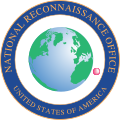External links
- NRO official website
- History of the US high-altitude SIGINT system
- History of the US reconnaissance system: imagery
| Current programs |
| |
|---|---|---|
| Facilities & commands |
| |
| Technology & Science | ||
| Satellite lines & projects |
| |
| People | ||
| History | ||
| Past programs |
| |
| Founders | ||
